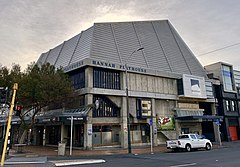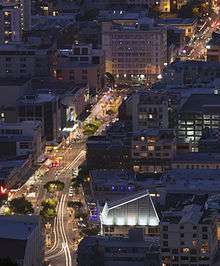Hannah Playhouse
The Hannah Playhouse is a theatre venue situated on the corner of Courtenay Place and Cambridge Terrace in central Wellington, New Zealand.[1] The Hannah Playhouse was named after Sheilah Winn of the Hannah family and was built to house the company Downstage Theatre.[2]
| Hannah Playhouse | |
|---|---|
 | |
| General information | |
| Location | 12 Cambridge Terrace, Wellington, New Zealand |
| Completed | 1973 |
| Owner | Experience Wellington |
| Design and construction | |
| Architect | James Beard |
| Awards and prizes | 1978 New Zealand Architecture Award; 2006 Award for Enduring Architecture |
Background
The design for the Hannah Playhouse took place in the mid 1960s and was designed by architect James Beard with initial design by Ron Parker.[2]
In 1968 the Hannah Playhouse Trust was formed with the purpose of building a theatre venue on the corner of Courtenay Place and Cambridge Terrace. Sheilah Winn gave a gift of $300,000 for this purpose so the Hannah Playhouse was named after her maternal family – the Hannah's; who also founded the Hannah's shoe company.[3] There were delays in starting the project which meant additional funds had to be raised.[4]
The theatre was built in 1973 and replaced the Downstage Theatre company's earlier premises upstairs on the same site. The Hannah Playhouse building was home to the company until 2013 when it closed. The building itself is still often referred to as Downstage Theatre.
Raymond Boyce MBE, a leading New Zealand theatre set and costume designer, was on the board of Downstage when the playhouse was built. Boyce became design consultant to the architects influencing the design of the flexible stage area and auditorium.[5][6] It was designed to be a dinner theatre with a flexible space that could accommodate an audience seated for dining, with options for the staging of the performance that could change for each show.[7]

It currently seats approximately 250 people in the auditorium, when it opened it had a capacity for 170 people at dining tables.[3][4]
Significance
The design of the Hannah Playhouse is a building which sits in the 1960s 'brutalist' category which refers to the raw, undoctored concrete that features in both the exterior and interior of the building.[8]
The building is part of a small group of unique performance spaces because of its asymmetric design, there include the Heinrich Tessenow's Hellerau Festpielhaus (1911) in Dresden, Germany, Manchester Royal Exchange (1976) in England, and São Paulo's Teatro Oficina (1984) in Brazil.[9]
It featured in an exhibition about modern architecture in 2010 called Long Live the Modern at the Dowse Art Museum in Wellington, New Zealand.[10] In the book that accompanied the exhibition the building is described thus:
"It asserts itself ... by adopting a sculptural, asymmetric roof form that addresses the corner site; and by taking its lead from brutalism's uncompromising, anti-bourgeois spirit, typified by the enthusiasm for unpainted off-form concrete." (Christine McCarthy)[2]
Awards
References
- Thomson, Rebecca (7 January 2010). "Downstage – a Wellington fixture". The Dominion Post. Fairfax Media. Retrieved 18 October 2018.
- McCarthy, Christine (2008). "Hannah Playhouse (also known as Downstage)". Long live the modern : New Zealand's new architecture, 1904-1984. Gatley, Julia. Auckland, N.Z.: Auckland University Press. p. 189. ISBN 978-1-86940-415-4. OCLC 228368046.
- "The Hannah's History Hannah Playhouse - What's on". Hannah Playhouse. Retrieved 2020-05-09.
- Smythe, John (2004). Downstage upfront : the first 40 years of New Zealand's longest-running professional theatre. Wellington, N.Z.: Victoria University Press. ISBN 0-86473-489-1. OCLC 60386677.
- Macdonald, Nikki (2019-07-10). "Obituary: Raymond Boyce: a life designed by serendipity". Stuff. Retrieved 2020-03-11.
- "In memory of Raymond Boyce". Creative New Zealand. 2019-07-02.
- Brisbane, Katherine, ed. (2001). The World Encyclopedia of Contemporary Theatre: Volume 5: Asia/Pacific, Volume 5. Editors: Ravi Chaturvedi, Ramendu Majumdar, Chua Soo Pong, Minoru Tanokura. London: Routledge. ISBN 0-203-98247-9. OCLC 648150215.
- Martin, Olivia (2018). "Hannah Playhouse: The Home of Downstage". Stqry. Retrieved 2020-05-09.
- Filmer, Andrew; Rufford, Juliet, eds. (2018). Performing architectures : projects, practices, pedagogies. London: Methuen Drama. ISBN 978-1-4742-4798-6. OCLC 1041897163.
- Edwards, Simon (2010-03-09). "Hutt's striking modern skyline". Stuff. Retrieved 2020-05-09.
Further references can be found in
External links
| Wikimedia Commons has media related to Hannah Playhouse. |